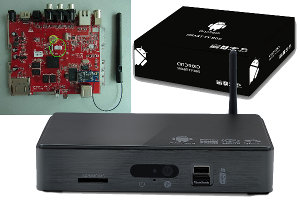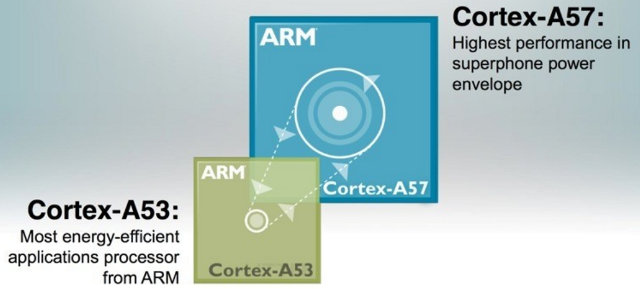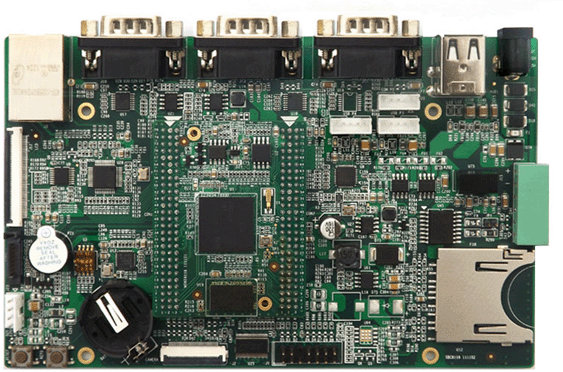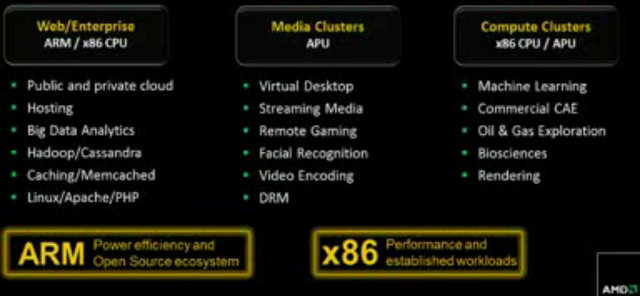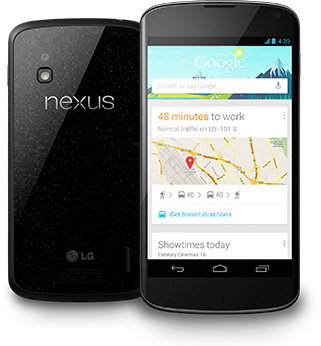J1nx (Peter Steenbergen) has spend a lot of time together with XBMC developers to try to bring XBMC (Linux) to ARM based set-top boxes, and initially AllWinner A10 processor seemed like a good candidate, unfortunately due to the lack of proper video engine libraries for Linux, progress on this SoC has been extremely slow. Then when Pivos and XBMC announced Pivos Xios DS set-top box based on AMLogic aml8726-M(1) would support XBMC natively, and the kernel and bootlooader (u-boot) source code was made available both on Pivos github account and AMLogic open source website, AML8726 series of processors appeared to be an ideal solution for this purpose. Instead of AML8726-M (aka AML8726-M1) which is limited to 512 MB, it was decided instead to use a faster processor AML8726-M3 that supports 1 GB RAM. The STB of choice is based on “MBX – f16ref” which should be some kind of development […]
ARM Unveils its First 64-bit Cores: ARM Cortex A53 (LITTLE) and Cortex A57 (big)
ARM Techcon 2012 started yesterday with a major announcement, as ARM unveiled the ARM Cortex A50 series, the first 64-bit ARM Core based on ARMv8 architecture. The company announced 2 cores that can be used independently or in combination to take advantage of big.LITTLE processing: Cortex-A57 – 64-bit core that offers 3x the performance of 2012 superphone in 32-bit, 5x power-efficiency and is scalable beyond 16 cores. It’s the big core in big.LITTLE. Cortex-A53 – 64-bit core that offers the same performance as Cortex A9 but with 4x power efficiency and 25% the size of today CPUs. It’s the LITTLE core in big.LITTLE. Those cores manufactured using 28nm, 20nm and eventually 14nm process technology will be used in smartphones, tablets. mobile computers and servers (See AMD/ARM announcement). They’ll be software compatible with ARMv7-A processors (Aarch32) which should greatly facilitate the transition and support both 64-bit and 32-bit OS and applications, […]
Embest SBC8118 Single Board Computer Based on TI AM1808 Processor
Embest recently unveiled the SBC8118 Single Board Computer, an industrial grade SBC powered by Texas Instruments AM1808 ARM9 processor with 128MB Mobile DDR2 RAM and 128MB NAND Flash. The SBC8118 Single Board Computer is aimed at medical, industrial automation, control, communication, and other cost sensitive applications. As you can see from the picture above, it is comprised of a CPU board and an expansion board. Here are the specifications of the CPU board (Mini8118): Processor – 375MHz TI AM1808 ARM926EJ-S Microcontroller (also supports 456MHz operation) Memory – 128 MByte Mobile DDR2 Storage – 128 MByte NAND Flash (on the rear of the board) & 8 Mbit SPI Flash Connectors – Two 2.0mm space 3*27-pin dip connectors and the expansion board: Audio/Video Interfaces: TFT LCD interface (50-pin FPC connector, RGB565) 4 line resistive Touch Screen interface Camera interface (30-pin FPC connector, supports CCD and CMOS cameras) Data Transfer Interfaces: Serial port: […]
AMD To Provide 64-Bit ARM Opteron Processors for the Server Market
AMD announced it will design processors based on 64-bit ARM technology in addition to its x86 processors for the cloud and data center servers. AMD will be the first company to provide both x86 and ARM solutions to the server market, and the first ARM-based server CPU is scheduled for 2014. There aren’t much details at this time, but AMD did say it will be take advantage of AMD SeaMicro Freedom supercompute fabric in order to link CPU, Ethernet and Storage and the processor will be sold as an AMD Opteron CPU. Interestingly, the company does not plan to design 64-bit ARM processor for the client market (e.g. Windows RT) for the time being. Red Hat and AMD partnered for the server software, and Red Hat has started to work to bring support for the next generation of 64-bit ARM server processors to the Fedora Project include 64-bit ARM OpenJDK. […]
New Features in Android 4.2 Jelly Bean
As Google unveiled Nexus 4 smartphone and Nexus 10 tablet, they also announced Android 4.2, the latest version of Google operating system, that brings the following new features. Photo Sphere Camera Going beyond panoramic photo shots, photo sphere allows you to generate a 360 degrees panorama by taking pictures in all direction, up, down, right and left. Head over Google maps to see a few examples. Keyboard with Gesture Typing You can now just glides over the letters you want to type, and the new improved keyboard will find the word you want to type. The keyboard is also said to be able to anticipate the next word allowing to type a full sentence by just selecting suggested words. Google also claims text-to-speech capabilities and voice typing have been improved, and you don’t need an internet connection to type with your voice anymore. Multiple User Profiles This is the most […]
Google Unveils LG Nexus 4 Smartphone and Samsung Nexus 10 Tablet Running Android 4.2
Event though it had to cancel the media event due to bad weather, Google made several important announcements yesterday with the LG Nexus 4 Smartphone based on Qualcomm Snapdragon S4 and Samsung Nexus 10 tablet powered by the latest ARM Cortex A15 Exynos 5250 processor. The company also announced Android 4.2 (still called Jelly Bean) which will run on both devices. I’ll provide more details on the new features of the latest version of Android in a separate post. Let’s see what kind of hardware the Nexus 4 has to offer: CPU – Qualcomm Snapdragon S4 Pro @ 1.5 GHz (Quad Core) System Memory – 2 GB RAM Storage – 8 or 16 GB internal storage Display – 4.7″ IPS display (1280×768) Camera – 8MP rear and 1.3 MP front cameras. Connectivity – Wi-Fi 802.11 b/g/n, NFC (Android Beam) and Bluetooth Mobile Network – Unlocked GSM/UMTS/HSPA+, GSM/EDGE/GPRS (850, 900, 1800, […]
The Yocto Project Release 1.3
The Yocto Project Release 1.3 has just been announced. This release codenamed “Danny” and based on Poky 8.0 is the fifth release of the project. The Yocto Project is a framework to assist developers in creating embedded Linux distributions. New features and updates for the Yocto Project 1.3 Improved terminal UI, which makes it easy to see the tasks that are currently executing, and avoids burying any warnings that are printed. Eliminated intermediate step when building cross compiler toolchain Relocatable SDK Large number of usability improvements in the Hob image building UI Upgraded eglibc to version 2.16 Upgraded gcc to version 4.7 Upgraded Linux kernel version to 3.4.11 Added yocto-bsp script for automating the initial parts of creating a new BSP Python functions now consistently use four spaces for indentation – no more having to try to match the mix of tabs and spaces in your recipes Disabled sharing shared […]
Xibo Digital Signage Version 1.4.0 Released
Xibo has just announced the release of Xibo 1.4.0 (codename: “Brorsen”). Contrary to version 1.3.0 which was a development release, Xibo 1.4.0 is a stable release and you should consider updating your current installations if you want to take advantage of some of the 27 new features and/or 108 bug fixes. This version replaces the previous stable version (1.2.2) released 18 months ago. If you are not familiar with Xibo, it is an open source Client/Server digital signage framework that can run in Windows (.NET implementation) and Linux (Client: Python, Server: LAMP). For some more details, you can read my introduction to Xibo and/or a “getting started” tutorial I wrote some time ago. Main new features in Xibo 1.4.0 Significant improvements to permissions – View, Edit and Delete permissions can now be set on the following items: Library Media Layouts Regions in Layouts Media on Region Timelines DataSets Display Groups […]


